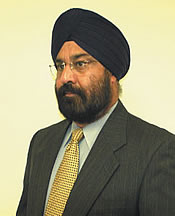|

Fine Painting & Decorating Co., Mountainside, New Jersey
by John Strieder
was considering what to call his new painting business back in 1981, his wife suggested the name of a vice president at the painting company that gave him his start.
“I had a mentor by the name of Mr. Herman Fine who was like a father to me in the company I worked for,” he says. “He always gave me the moral support to try it on my own.”
 Singh took his wife’s advice and founded Fine Painting & Decorating Co. So just for the record, Fine is his mentor’s name, not his. “I still get a lot of mail addressed to Anthony Fine,” he says. Singh took his wife’s advice and founded Fine Painting & Decorating Co. So just for the record, Fine is his mentor’s name, not his. “I still get a lot of mail addressed to Anthony Fine,” he says.
It’s also true, of course, that Fine Painting & Decorating Co. does fine work. The company has the accolades to prove it.
In 2005, Fine won the Construction Excellence Award in the Acoustical Solutions category from the Ceilings and Interior Systems Construction Association (CISCA) for its work for Jazz at Lincoln Center. The American Subcontractors Association of New Jersey named the firm Subcontractor of the Year last year and gave it a Safety Award to boot.
Fine Painting has also won recognition among minority-owned businesses, as Tony Singh was born in India. The company won Minority Service Firm of the year in 2002 from the U.S. Department of Commerce Minority Business Development Agency (MBDA), and it was named 2005 Supplier of the Year MBE Class III by the New York and New Jersey Minority Supplier Development Council Inc.
Specializing in industrial and commercial work, and adept at painting, wall-covering and fabric acoustical panel installation, Fine Painting is one of the largest commercial painting firms in New York, New Jersey and Connecticut.
The company’s mission statement states, among other things, that the company prizes long-term relationships and such values as fairness, respect and dignity.
The firm rakes in the work. Over the course of a single year, Fine Painting will finish 500 to 600 jobs, apply 250,000 gallons of paint and put up 70,000 yards of wall coverings. The company does lot of power plants, sewage plants, subways, airports, schools and manufacturing facilities. Recent clients range from the Federal courthouse in Brooklyn, N.Y., to big pharmaceutical manufacturers in New Jersey. “Our niche is, the more complicated the job, the more we like it,” says Singh.
Drug companies are starting to spend money again, says Singh, and his company will get more work as they expand. Pharmaceutical manufacturing facilities often must be painted with coatings that have a lot of fiberglass mesh, then topped with a couple of coats of epoxy. “Extreme quality control is required in these pharmaceutical companies,” he says.
At power plants, safety and quality control are key, he says. “The guy is checking every little thing. So we have to be perfect in application.”
A painter could miss only one quarter inch, one nut and bolt, on a $4 million painting job, and an inspector will call it to everyone’s attention, he says. Mil thickness, application temperature and prep work must be flawless. “They want it to go exactly like the book. Some people will go, ‘uhh, it’s just painting steel.’ Not on those jobs.”
 Fine Painting employs a quality control specialist to monitor these jobs on site. The company has achieved QP1 and QP2 certifications from the Society for Protective Coatings (SSPC). Fine Painting employs a quality control specialist to monitor these jobs on site. The company has achieved QP1 and QP2 certifications from the Society for Protective Coatings (SSPC).
Fine also hired a full-time safety director a few years ago. Safety is becoming more of a priority in the bidding process, and a good safety record earns points just like a low price quote does, Singh says. “General contractors can see we have a safety program. All things being equal, if you have a good safety record, they’re going to choose you.”
On the other hand, Fine Painting avoids residential work because the margins are low, and it doesn’t do bridges. The company did not take any significant decorative painting jobs in 2005, Singh says, although it has applied gold leaf at Radio City Music Hall in partnership with John Canning Co.
In the last five years, corporations scaled back the amount of money they were spending on painters, he says. But at the same time, a lot of public money was spent hiring contractors to paint schools and airports. The private sector started to pick up again in 2005, he says. “I saw a lot of work in financial companies — office renovations. Marketwise, next year should be OK for the painting contractors. I think it should be a good year.”
Singh came to painting through civil engineering. He earned an undergraduate degree in 1974 in India, then came to the United States to obtain a master’s degree. He enrolled at Oklahoma State, but transferred to the New Jersey Institute of Technology to finish. “Oklahoma was a little too backward,” he says. “There was a lot of racism in those days.”
While attending classes in the evenings, he took a day job estimating for a painting contractor. By the time he left that company in 1981 to start Fine Painting, he was a vice president.
Singh still loves civil engineering. But perhaps more importantly, he’s found the degree useful in his career as president of a painting company. “At the level of work we’re at, you almost have to be an engineer,” he says. “It’s just so complicated today.”
He has made education his personal mission, both inside and outside his company. Fine’s office staffers are required to attend 40 hours of training per year, while field workers attend an annual safety orientation. “One of my hobbies is to teach. That’s my mission in life — to share all the knowledge I have, to pass it on to a younger generation.”
Singh makes a point of mentoring small minority contracting firms, and favors minority-owned firms when hiring subcontractors. Also, Fine Painting is a union contractor, and Singh has embraced that concept as well. He is co-chair of the Labor Management Cooperative Initiative, which aims to promote understanding between labor and employers while growing the union finishing industry. “My idea is if this is the market I’m going to work in, I might as well be proactive and bring change to it.”
Successful people can be reluctant to mentor people who, if successful, may become their competitors. Singh doesn’t have that problem. Some of his employees have gone on to start their own firms, just as he did with the people who mentored him. “And I wish them good luck,” he says. “It’s a big world out there, there’s plenty for everyone. I believe if you teach people and treat them fairly, they will always be there for you.”
Right now, Fine Painting definitely has its share. The firm has grown from its beginnings as a one-man operation to employ roughly 250 people in three offices, and it acquired David Friedland Painting Co., another New Jersey-based commercial painting company, in 2005. Its New York office is 7 years old, a Connecticut location is 21⁄2 years old, and a fourth location recently opened in Portland, Ore. “We’re trying to go West Coast, get a West Coast presence,” Singh says. “We want to expand geographically, doing things we know how to do best.”

|

